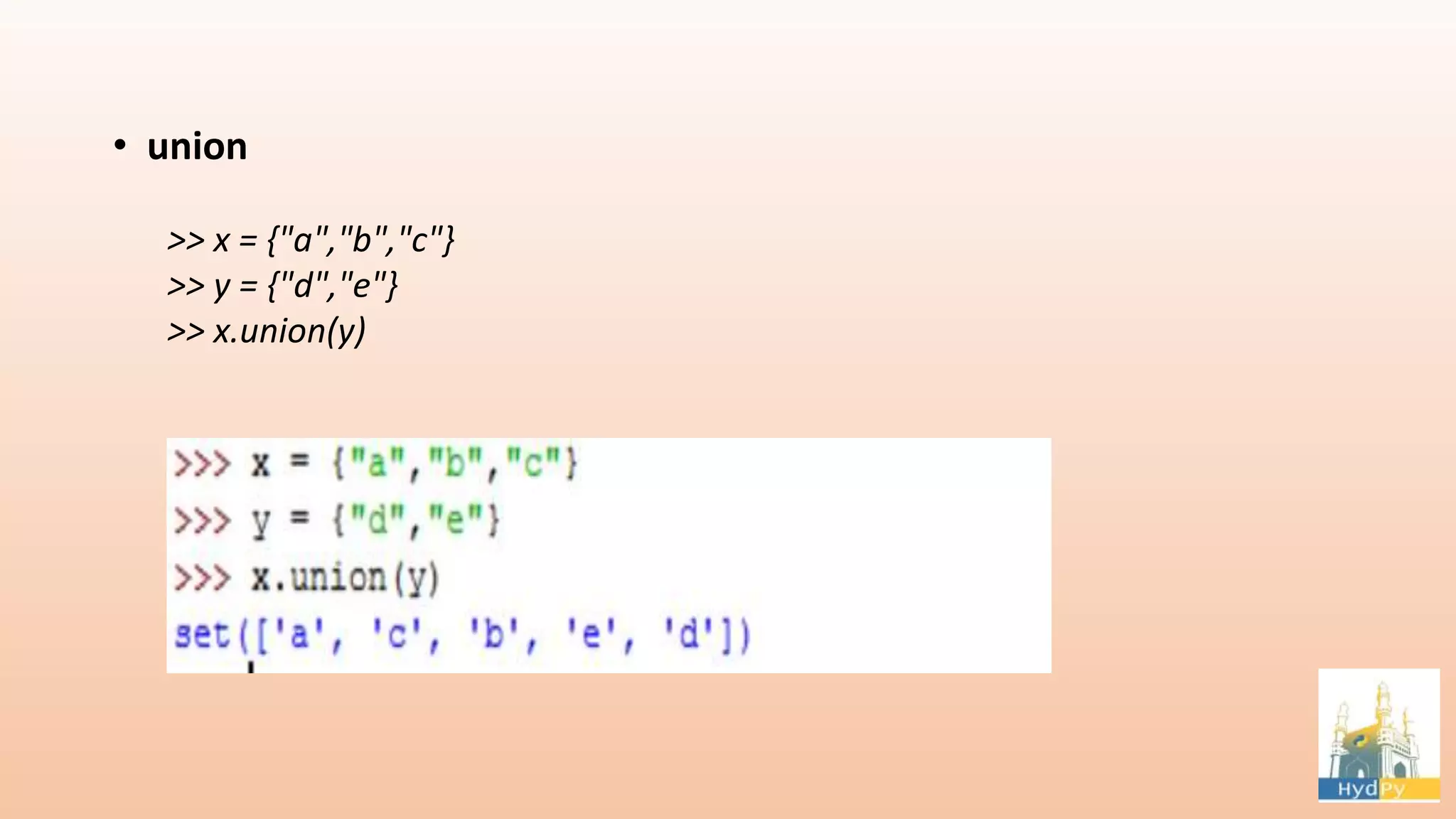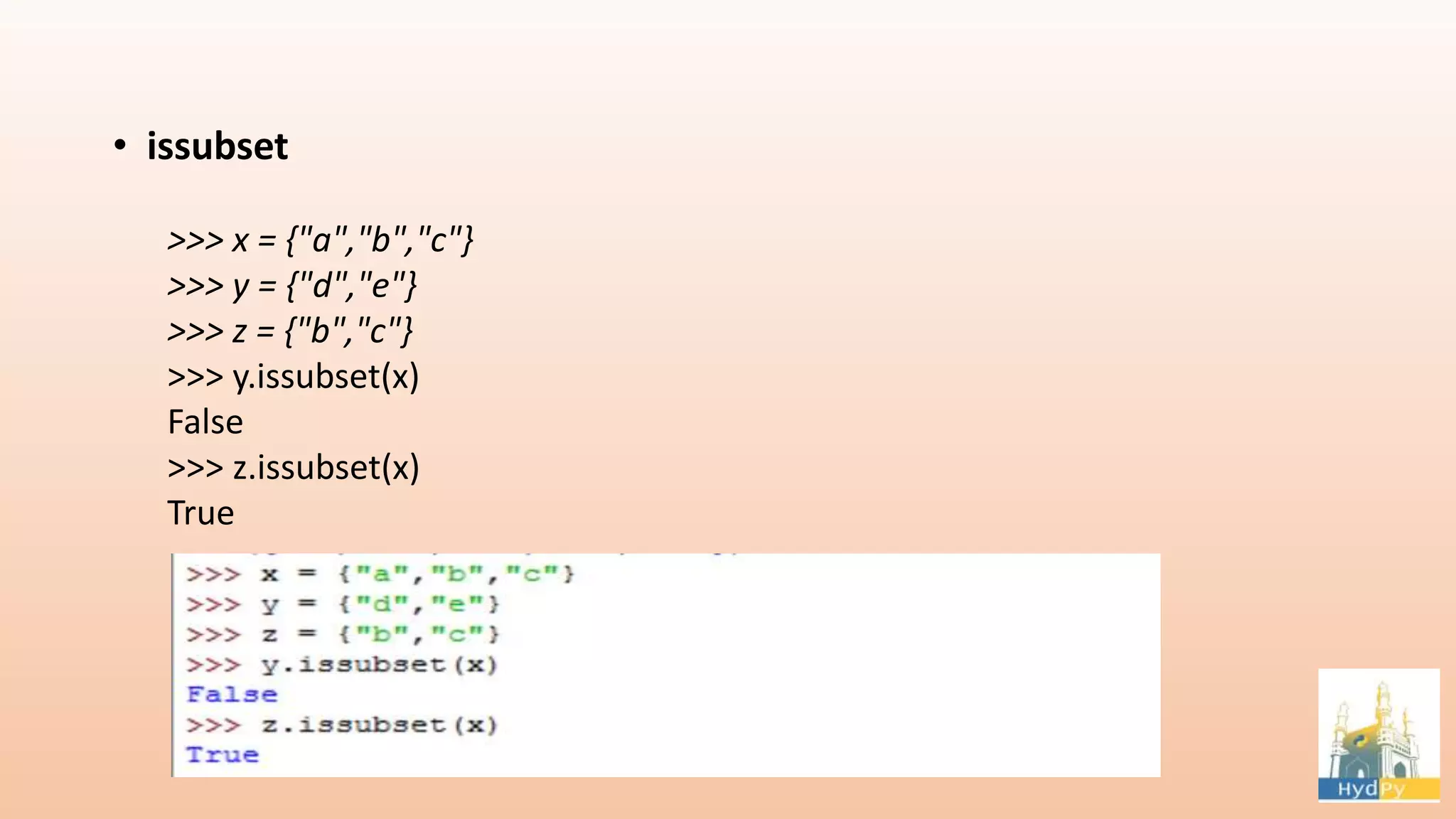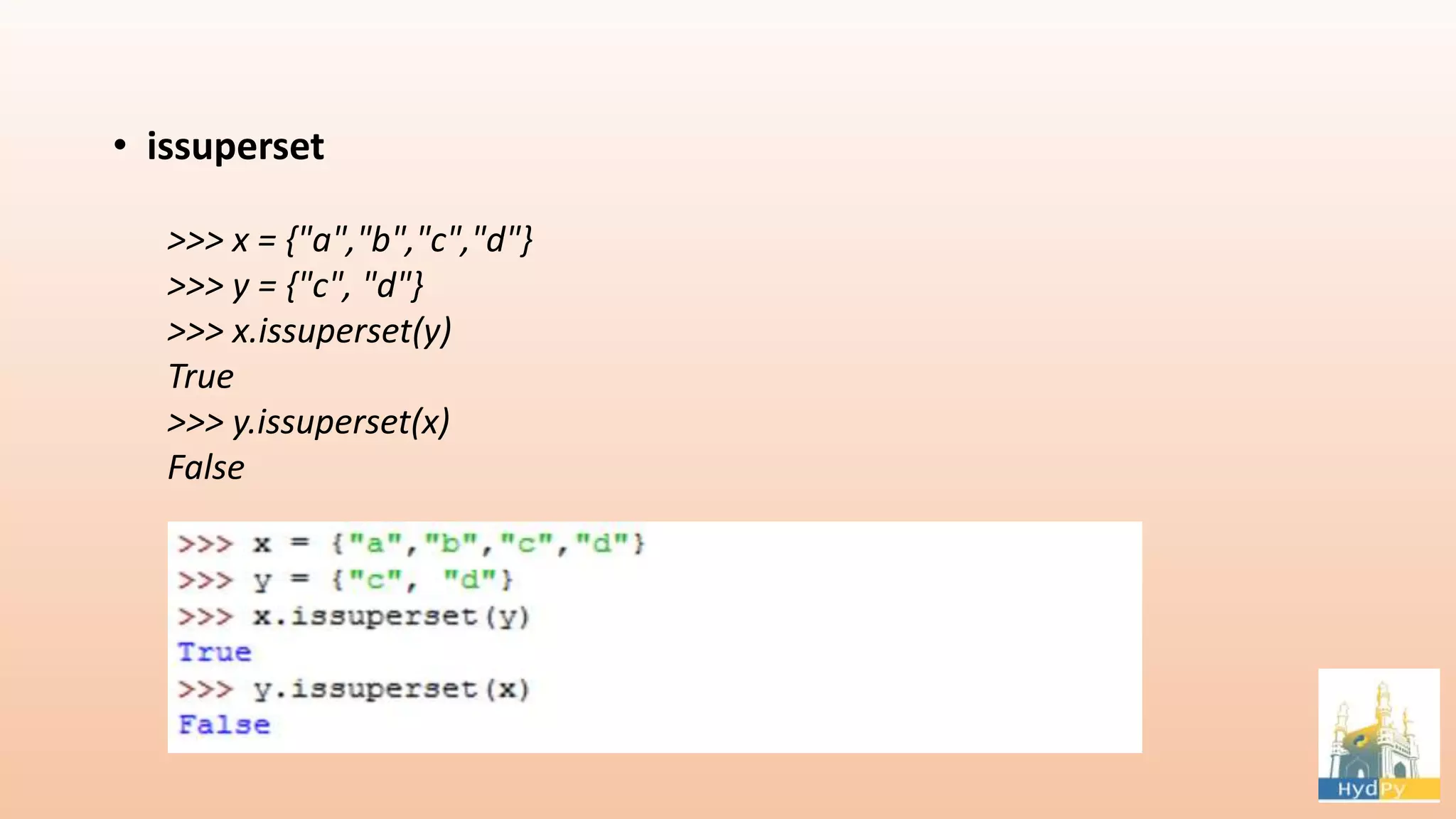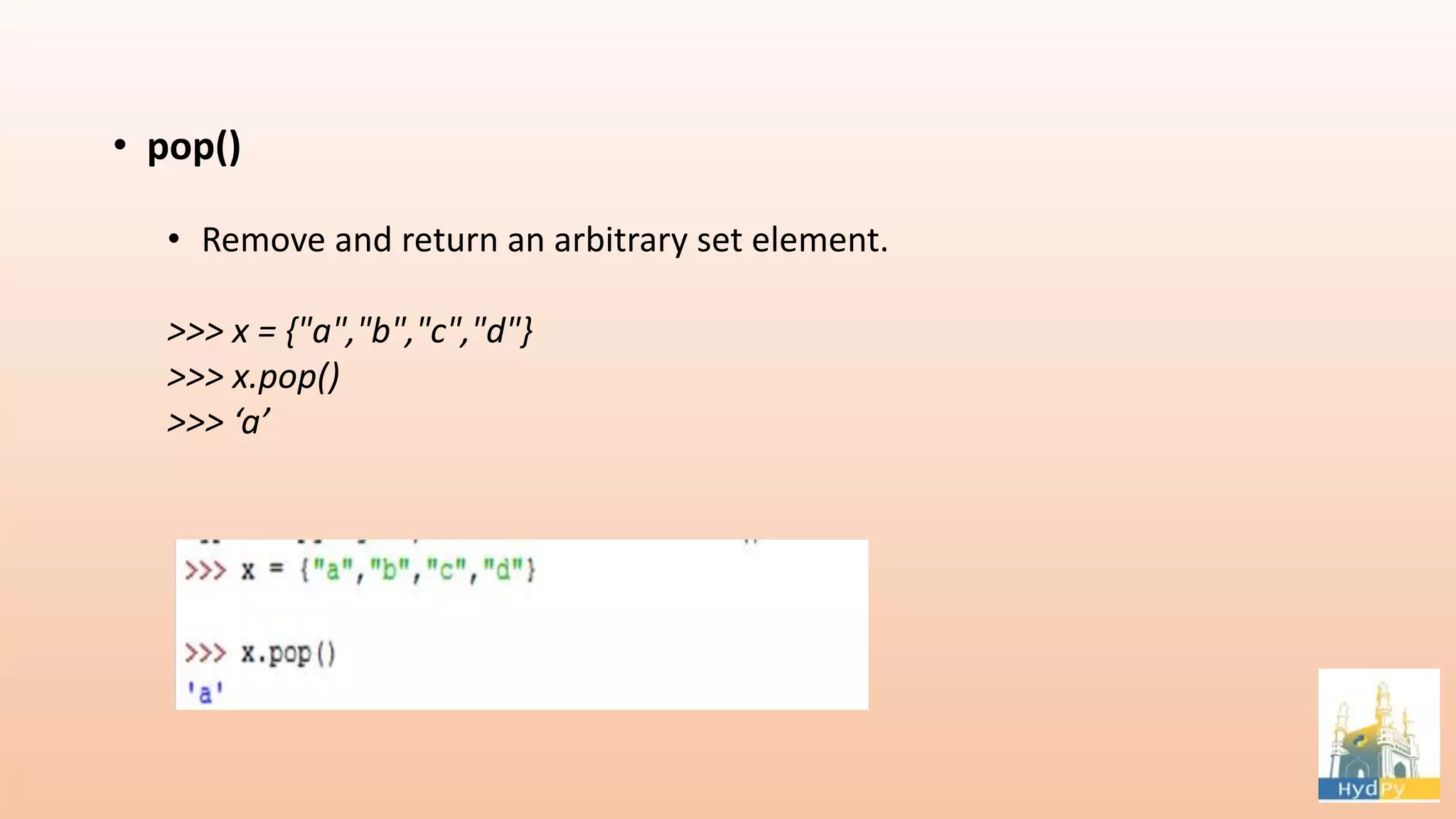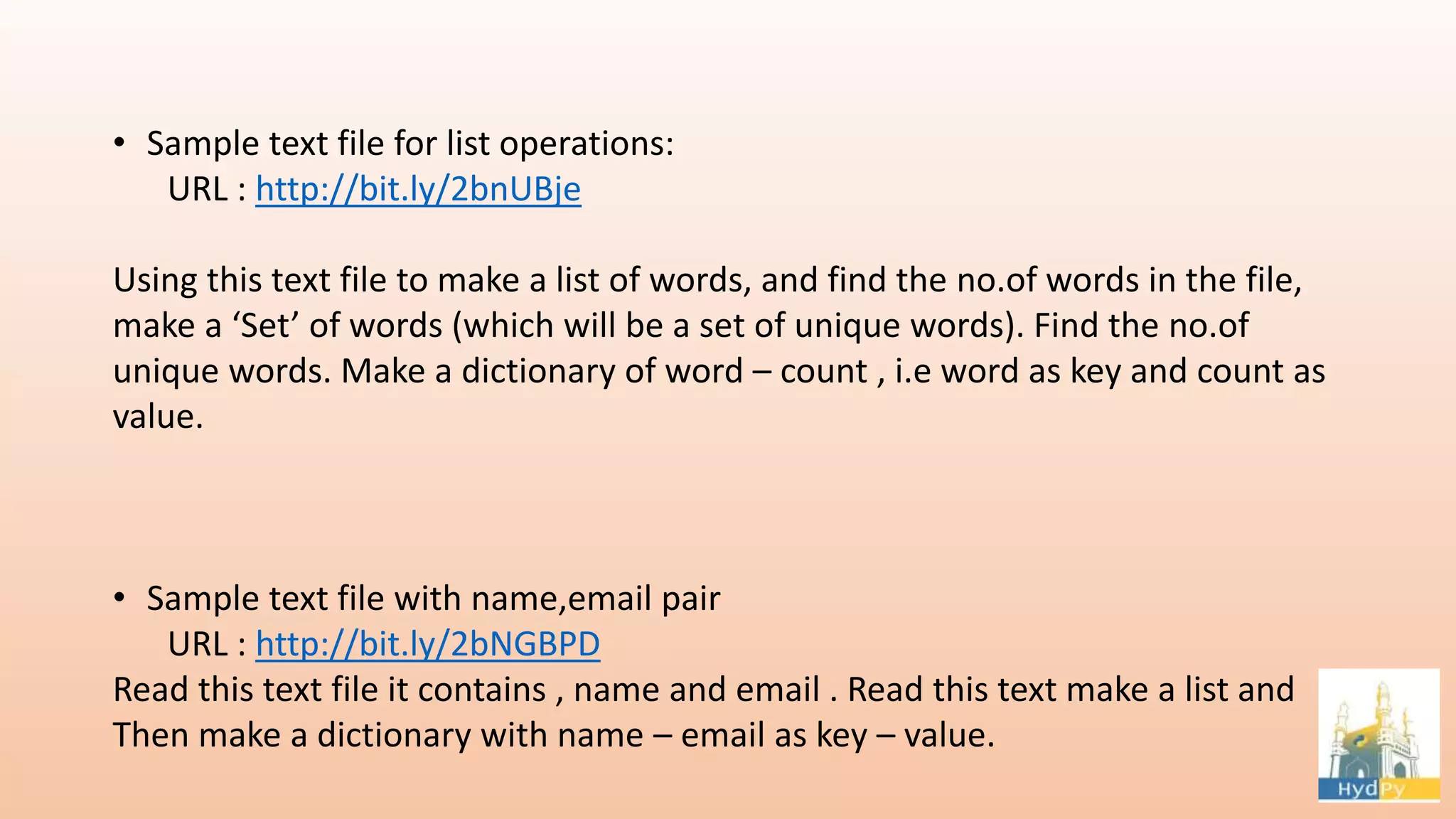The document provides an overview of data structures in Python, detailing both built-in (like lists, tuples, dictionaries, and sets) and user-defined structures. It explains how to create, manipulate, and access various data structure elements, alongside practical programming exercises. Key methods for lists, dictionaries, tuples, and sets are included, highlighting their functionalities and use cases.



![Lists • An ordered collection of items • List items does not need to be of same type We can have numbers, strings , list etc in the same list • List notation • A = [1,”This is a list”, ‘c’,2.5] • B = [] • C = list()](https://image.slidesharecdn.com/datastructuresinpython-160827123636/75/Datastructures-in-python-4-2048.jpg)

![• Make a list using string >>> lst = 'Welcome to meetup'.split() >>> lst ['Welcome', 'to', 'meetup'] >>> lst = 'What,a,wonderful,world'.split(',') >>> lst ['What', 'a', 'wonderful', 'world']](https://image.slidesharecdn.com/datastructuresinpython-160827123636/75/Datastructures-in-python-6-2048.jpg)
![• Access the items in the list >> names = [ ‘Rahul’, ‘Mahesh, ‘Aishwarya’ ] • Read one : >> names[0] >> Rahul >> names[-1] >> Aishwarya • Read one at a time : >> for name in names: print name Rahul Mahesh Aishwarya](https://image.slidesharecdn.com/datastructuresinpython-160827123636/75/Datastructures-in-python-7-2048.jpg)
![Methods of Lists • List.append(x) – Adds an item to the end of the list Eg: >> list_items = [1, 2, 3, 4, 5] >> list_items.append(6) >> list_items >> [ 1, 2, 3, 4, 5, 6 ]](https://image.slidesharecdn.com/datastructuresinpython-160827123636/75/Datastructures-in-python-8-2048.jpg)
![• List.extend(L) - Extends the list by appending all the items in the given list ‘L’ to the existing list Eg: >> list_items = [1, 2, 3, 4, 5] >> list_items.extend([6, 7, 8, 9]) >> list_items >> [ 1, 2, 3, 4, 5, 6, 7, 8 , 9 ]](https://image.slidesharecdn.com/datastructuresinpython-160827123636/75/Datastructures-in-python-9-2048.jpg)
![• List.insert(i,x) - Inserts an item x at index i Eg: >> list_items = [1, 2, 3, 4, 5] >> list_items.insert(3, 10) >> list_items >> [ 1, 2, 3, 10, 4, 5]](https://image.slidesharecdn.com/datastructuresinpython-160827123636/75/Datastructures-in-python-10-2048.jpg)
![• List.remove(x) - Removes the first occurrence of the item from the list whose value is x Eg: >> list_items = [1, 5, 3, 4, 5, 5] >> list_items.remove(5) >> list_items >> [ 1, 3, 4, 5, 5]](https://image.slidesharecdn.com/datastructuresinpython-160827123636/75/Datastructures-in-python-11-2048.jpg)
![• List.pop(i) - Remove and returns item at index i,default value of i is last index of the list Eg: >> list_items = [1, 5, 3, 4, 5, 8] >> list_items.pop() >> 8 >> lst >> [1, 5, 3, 4, 5] >> list_items.pop(2) >> 3 >> lst [1, 5, 4, 5]](https://image.slidesharecdn.com/datastructuresinpython-160827123636/75/Datastructures-in-python-12-2048.jpg)
![Some other methods of Lists • >> a = [1, 2, 3, 4, 5, 6, 7, 6] • a.count(x) # Returns occurrence of specified x >> a.count(6) >> 2 • a.index(x) # Returns the first index where the given value appears >> a.index(6) >> 5 • a.reverse() # Reverses order of list >> a.reverse() >> [6, 7, 6, 5, 4, 3, 2, 1] • a.sort() >> a >> [1, 2, 3, 4, 5, 6, 6, 7]](https://image.slidesharecdn.com/datastructuresinpython-160827123636/75/Datastructures-in-python-13-2048.jpg)
![Slicing a List • List[ start, stop] >> lst = list(‘Monty Python’) >> lst >> ['M', 'o', 'n', 't', 'y', ' ', 'P', 'y', 't', 'h', 'o', 'n'] >> lst[6:10] >> ['P', 'y', 't', 'h'] >> lst[0 : 5] >> ['M', 'o', 'n', 't', 'y']](https://image.slidesharecdn.com/datastructuresinpython-160827123636/75/Datastructures-in-python-14-2048.jpg)
![>> lst[6: 10] >> [''P', 'y', 't', 'h', 'o'] >> lst[-12 : -7] >> ['M', 'o', 'n', 't', 'y'] >> lst[:5] >> ['M', 'o', 'n', 't', 'y'] >> lst[5:] >> [' ', 'P', 'y', 't', 'h', 'o', 'n']](https://image.slidesharecdn.com/datastructuresinpython-160827123636/75/Datastructures-in-python-15-2048.jpg)

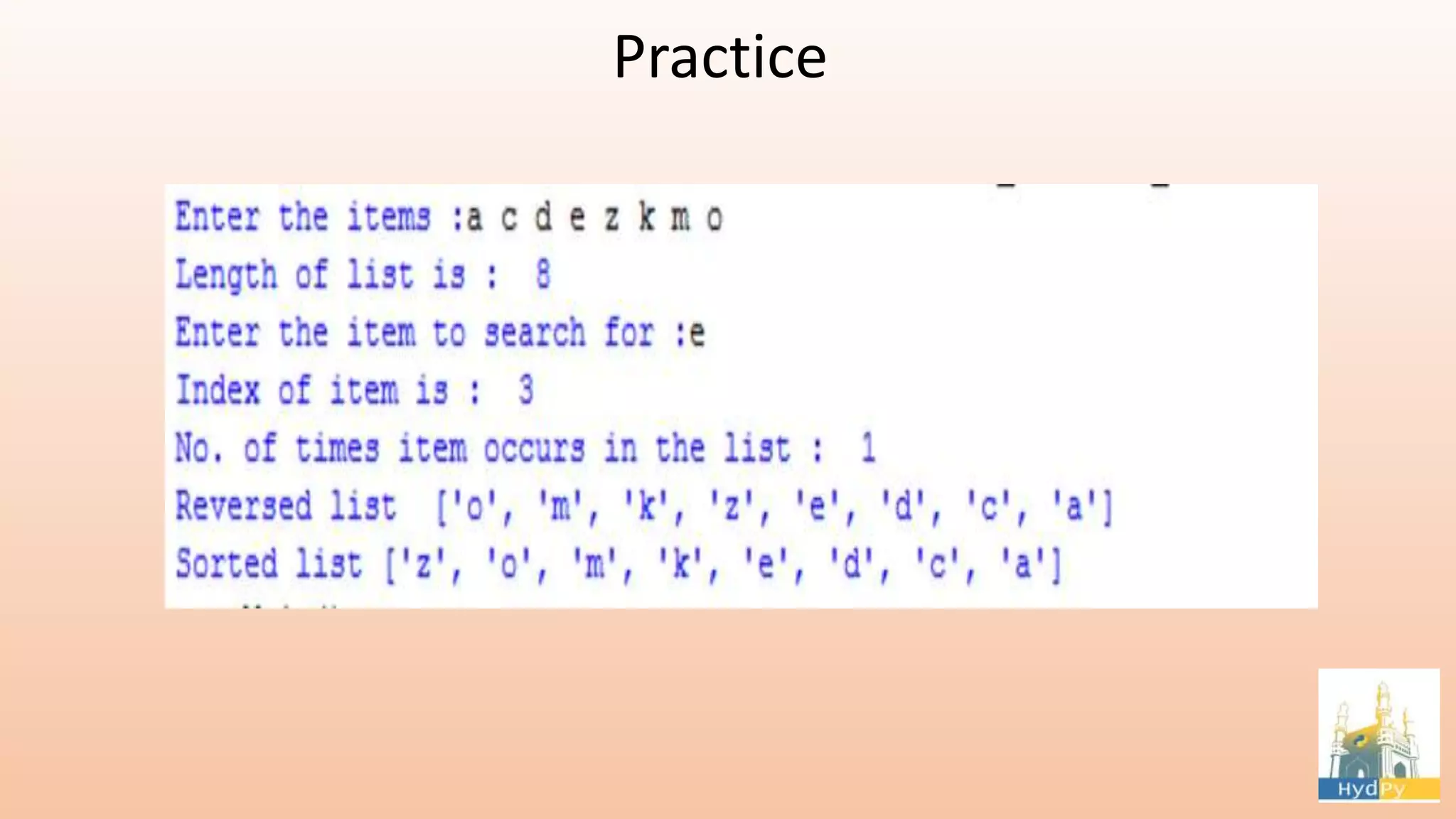
![Dictionary • Consists of Key– Value pair • Keys needs to unique • Items of the dictionary are not ordered Eg: >> empty_dict = dict() >> empty_dict >> {} >> phonebook = {'Rock': 999999999, 'Rashmi': 888888888, 'Mohan': 777777777} >> phonebook >> {'Rock': 999999999, 'Rashmi': 888888888, 'Mohan': 777777777} >> Phonebook['Rock‘] >> 999999999](https://image.slidesharecdn.com/datastructuresinpython-160827123636/75/Datastructures-in-python-18-2048.jpg)
![Modifying a Dictionary >> phonebook = {'Rock': 999999999, 'Rashmi': 888888888, 'Mohan': 777777777} >> phonebook['Rock‘] = 666666666 >> phonebook >> {'Rock': 666666666, 'Rashmi': 888888888, 'Mohan': 777777777} >> phonebook['Ricky'] = 3333333333 >> phonebook >> {'Rock': 999999999, 'Ricky': 3333333333, 'Rashmi': 888888888, 'Mohan': 777777777}](https://image.slidesharecdn.com/datastructuresinpython-160827123636/75/Datastructures-in-python-19-2048.jpg)
![Methods in Dictionary dict.keys() >> phonebook = {'Rock': 999999999, 'Rashmi': 888888888, 'Mohan': 777777777} >> phonebook.keys() >> ['Mohan', 'Rashmi', 'Rock'] dict.values() >> phonebook = {'Rock': 999999999, 'Rashmi': 888888888, 'Mohan': 777777777} >> phonebook.values() >> [777777777, 888888888, 999999999]](https://image.slidesharecdn.com/datastructuresinpython-160827123636/75/Datastructures-in-python-20-2048.jpg)
![• dict.items() >> phonebook = {'Rock': 999999999, 'Rashmi': 888888888, 'Mohan': 777777777} >> phonebook.items() >> [('Mohan', 777777777), ('Rashmi', 888888888), ('Rock', 999999999)]](https://image.slidesharecdn.com/datastructuresinpython-160827123636/75/Datastructures-in-python-21-2048.jpg)


![• dict.get(key) >> phonebook = {'Rock': 999999999, 'Rashmi': 888888888, 'Mohan': 777777777} >> phonebook['Akshay'] >> phonebook.get('Mohan')](https://image.slidesharecdn.com/datastructuresinpython-160827123636/75/Datastructures-in-python-24-2048.jpg)
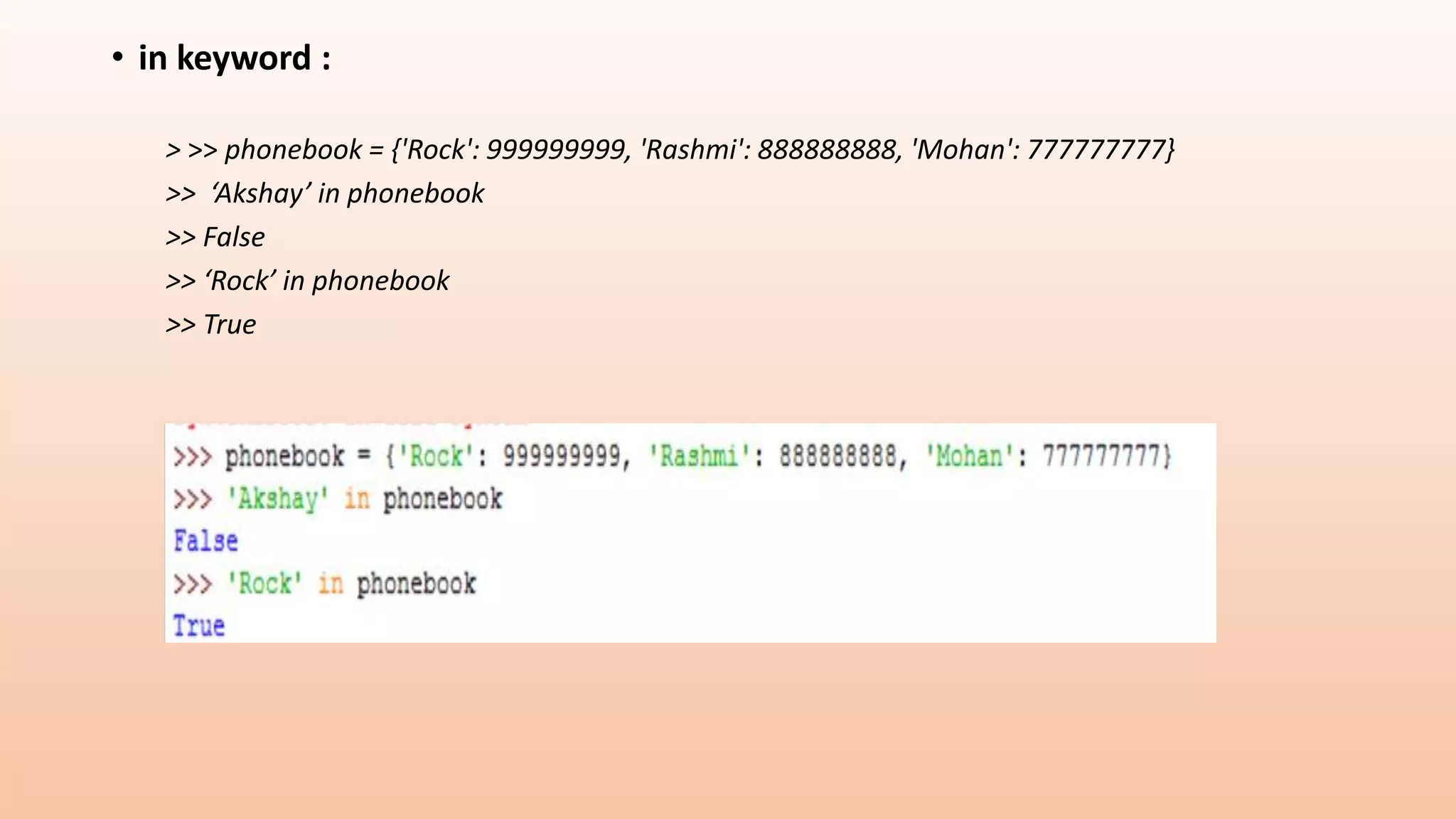
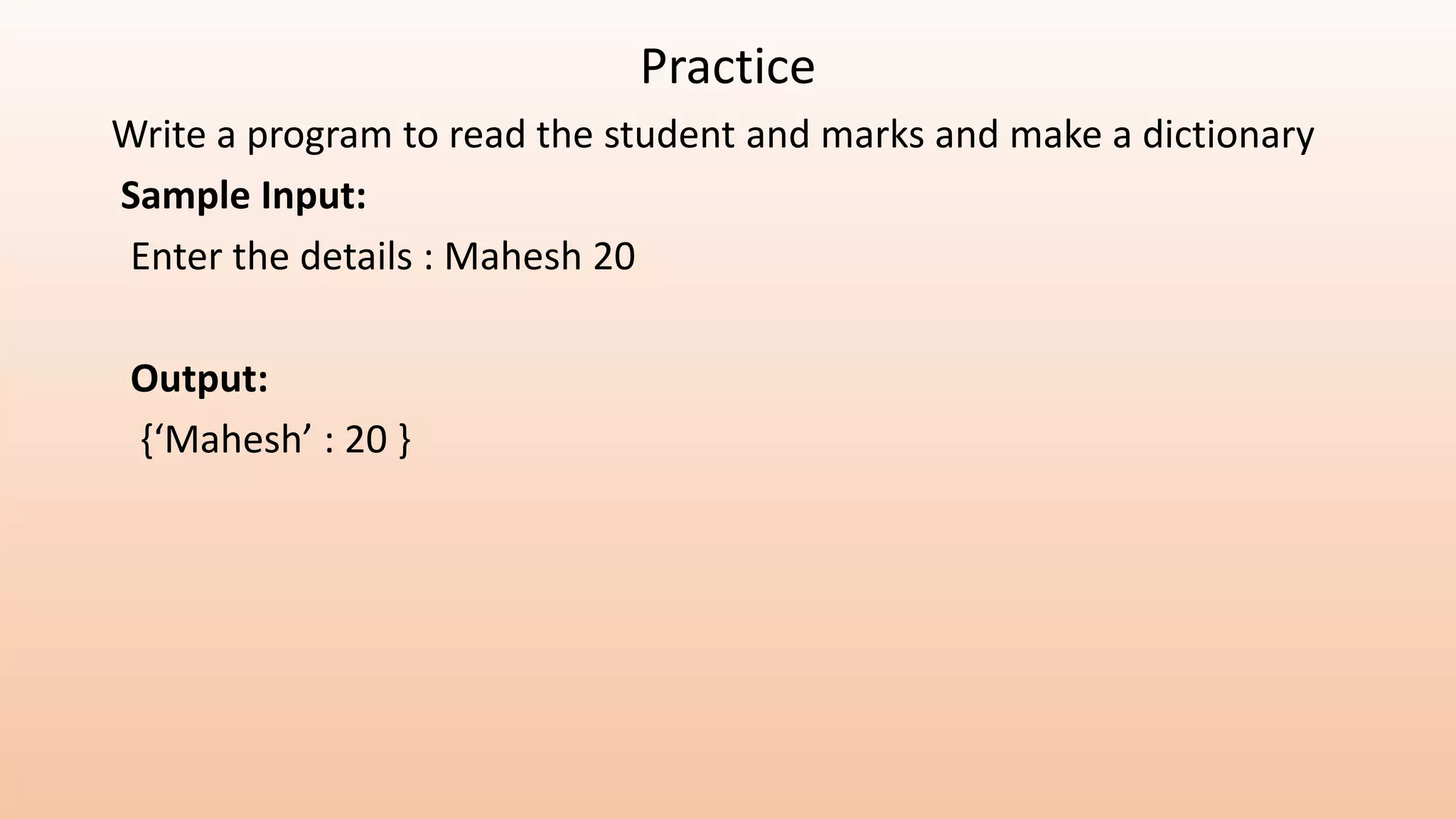


![Accessing items in Tuple • Item can be access using the index >> languages = ('Hindi','English','Telugu','Gujarati','Marathi') >> languages[0] >> 'Hindi' • Slicing can be used in Tuple >> languages[0:3] ('Hindi', 'English', 'Telugu')](https://image.slidesharecdn.com/datastructuresinpython-160827123636/75/Datastructures-in-python-29-2048.jpg)
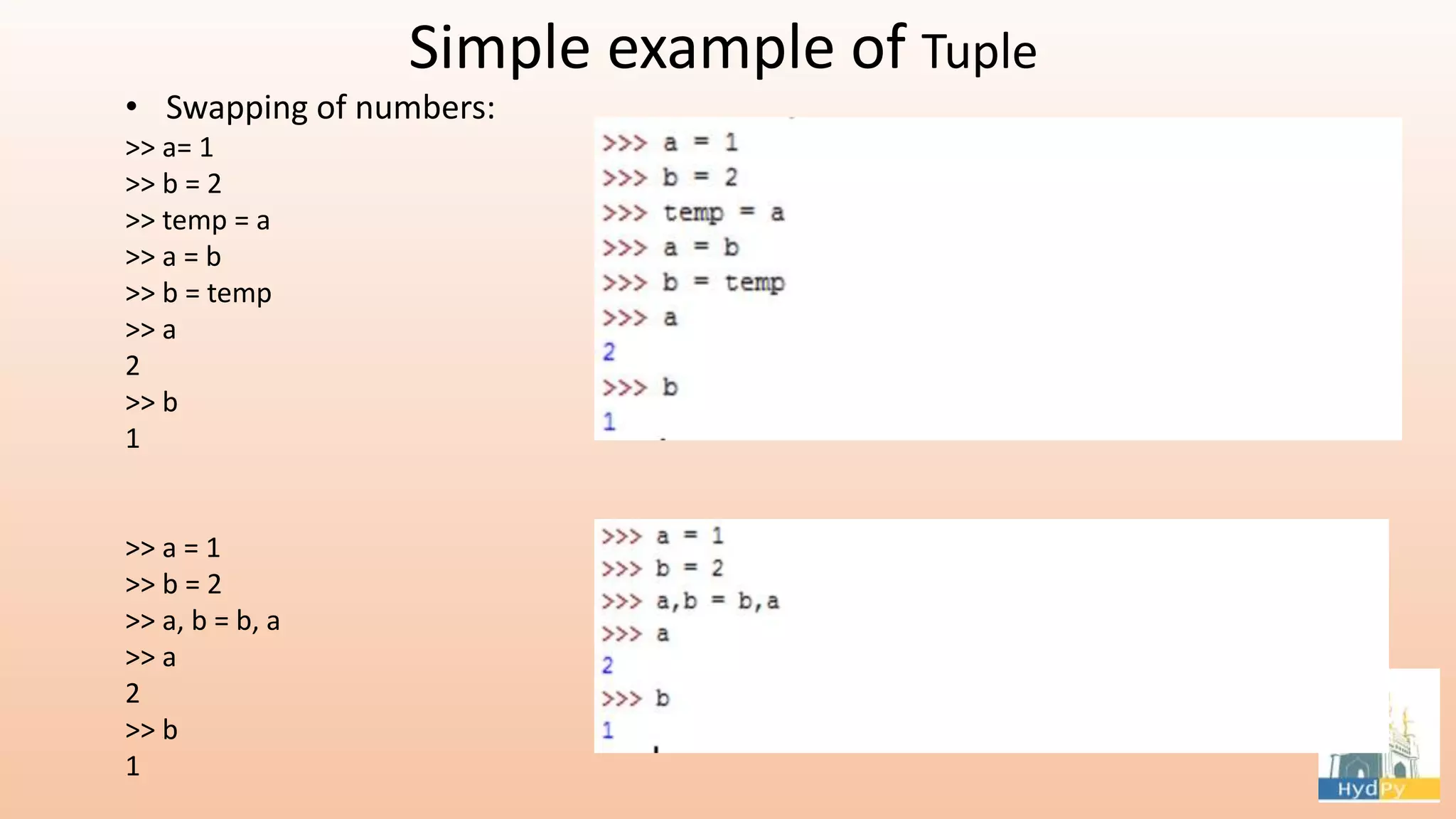
![Set • Sets are unordered collections of simple objects • Unique collections of immutable objects • Define a Set: >> set1 = set() >> set2 = {'Ramesh','Mahes','Suresh'} >> country = set(['India','America','Africa']) >> country >> set(['Africa', 'America', 'India', 'China'])](https://image.slidesharecdn.com/datastructuresinpython-160827123636/75/Datastructures-in-python-31-2048.jpg)
![Methods in Set • Set.add(element) >> set2 = {'Ramesh','Mahes','Suresh'} >> set2.add('Himesh') >> set2 >> set(['Himesh', 'Ramesh', 'Suresh', 'Mahes'])](https://image.slidesharecdn.com/datastructuresinpython-160827123636/75/Datastructures-in-python-32-2048.jpg)
![• copy >> names = {'Ramesh','Mahesh','Suresh'} >> new_names = names.copy() >> new_names >> set(['Mahesh', 'Ramesh', 'Suresh'])](https://image.slidesharecdn.com/datastructuresinpython-160827123636/75/Datastructures-in-python-33-2048.jpg)
![• clear >> names = {'Ramesh','Mahesh','Suresh'} >> names.clear() >> names >> set([])](https://image.slidesharecdn.com/datastructuresinpython-160827123636/75/Datastructures-in-python-34-2048.jpg)
![• difference >> x = {"a","b","c","d","e"} >> y = {"b","c"} >> x.difference(y) >> set(['a', 'e', 'd'])](https://image.slidesharecdn.com/datastructuresinpython-160827123636/75/Datastructures-in-python-35-2048.jpg)
![• discard(ele) >> x = {"a","b","c","d","e"} >> x.discard("b") >> x >> set(['a', ‘c', 'e', 'd'])](https://image.slidesharecdn.com/datastructuresinpython-160827123636/75/Datastructures-in-python-36-2048.jpg)
![• remove(ele) >> x = {"a","b","c","d","e"} >> x.remove("b") >> x >> set(['a', ‘c', 'e', 'd'])](https://image.slidesharecdn.com/datastructuresinpython-160827123636/75/Datastructures-in-python-37-2048.jpg)
![• intersection >> x = {"a","b","c"} >> y = {"d","e"} >> x.intersection(y) >> set([]) >> y.add("b") >> x.intersection(y) >> set(["b"])](https://image.slidesharecdn.com/datastructuresinpython-160827123636/75/Datastructures-in-python-38-2048.jpg)
